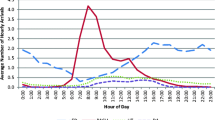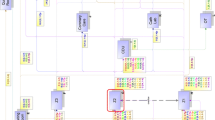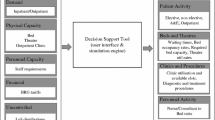Abstract
The provision of hospital resources, such as beds, operating theatres and nurses, is a matter of considerable public and political concern and has been the subject of widespread debate [1, 2, 3]. The political element of healthcare emphasises the need for objective methods and tools to inform the debate and provide a better foundation for decision-making. There is considerable scope for operational models to be widely used for this purpose. An appreciation of the dynamics governing a hospital system, and the flow of patients through it, point towards the need for sophisticated capacity models reflecting the complexity, uncertainty, variability and limited resources. Working alongside managers and clinicians from participating hospitals, this paper proposes a generic framework for modelling of hospital resources in the light of perceived user-needs and real-life hospital processes. The proposed framework incorporates the need for patient classification techniques to be adopted, which forms a key differentiator between this approach and other attempts to produce practical capacity planning and management tools. Statistically and clinically meaningful patient groupings may then be fed into developed simulation models and individual patients from each group passed through the particular hospital system of concern. The effectiveness of the framework is demonstrated through the development and use of an integrated hospital capacity tool.
Similar content being viewed by others
References
S. Capewell, The continuing rise in emergency admissions, British Medical Journal 312 (1996) 991-992.
O. Blatchford and S. Capewell, Emergency medical admissions: Taking stock and planning for winter, British Medical Journal 315 (1997) 1322-1323.
A. Bagust, M. Place and J.W. Posnett, Dynamics of bed use in accommodating emergency admissions: Stochastic simulation model, British Medical Journal 319 (1999) 155-158.
A.K. Shahani, Reasonable averages that give wrong answers, Teaching Statistics 3 (1991) 50-54.
E.P.C. Kao and G.G. Tung, Bed allocation in a public health care delivery service, Management Science 27 (1991) 507-520.
X. Huang, A planning model for requirement of emergency beds, IMA Journal of Math. Applied to Medical Biology 12 (1995) 345-353.
R.J. Ruth, A mixed integer programming model for regional planning of a hospital inpatient service, Management Science 27 (1981) 521-533.
W.T. Lin, Modelling and forecasting hospital patient movements: Univariate and multiple time series approaches, IJF (The Netherlands) 5 (1989) 195-208.
M.B. Dumas, Simulation modelling for hospital bed planning, Simulation 43 (1984) 69-78.
G. Vassilacopoulos, A simulation model for bed allocation to hospital inpatient departments, Simulation 45 (1985) 233-241.
D. Gove, D. Hewett and A.K. Shahani, Towards a model for hospital case-load decision support, IMA Journal of Math. Applied to Medical Biology 12 (1995) 329-338.
I.H. Wright et al., Statistical modelling to predict elective surgery time: Comparison with a computer scheduling system and surgeon provided estimates, Anaesthesiology 85 (1996) 1235-1245.
T. Gordon et al., Surgical unit time utilisation review: Resource utilisation and management implications, Journal of Medical Systems 12 (1998) 169-179.
H. Wolfe and J.P. Young, Staffing the nursing unit, part I: Controlled variable staffing, Nursing Research 14 (1963) 236-243.
E.S. Rosenbloom and N.F. Goertzen, Cyclic nurse scheduling, European Journal of Operational Research 31 (1987) 19-23.
S.P. Silfred and W.C. Benton, Workforce staffing and scheduling: Hospital nursing specific models, European Journal of Operational Research 60 (1992) 223-246.
S.P. Silfred and W.C. Benton, A decision model for shift scheduling of nurses, European Journal of Operational Research 74 (1994) 519-527.
K.A. Dowsland and J.M. Thompson, Solving a nurse scheduling problem with knapsacks, networks and tabu search, Journal of the Operational Research Society 51 (2000) 825-833.
L. Breiman et al., Classification and Regression Trees (Chapman & Hall, London, 1984).
M.E. Smith et al., Case-mix groups for hospital-based home care, Medical Care 30 (1992) 1-16.
C. Garbe et al., Primary Cutaneous Melanoma — Identification of prognostic groups and estimation of individual prognosis for 5,093 patients, Cancer 75 (1995) 2484-2491.
S. Ridley et al., Classification trees: A possible method for iso-resource grouping in intensive care, Anaesthesia 53 (1998) 833-840.
J.A. Nelder and R. Mead, A simplex method for function minimisation, Computer Journal 7 (1965) 308-313.
R. O'Neil, Algorithm AS47: Function minimisation using a simplex procedure, Applied Statistics 20 (1971) 338-345.
J.D. Hawkins et al., TOCHSIM manual (Southampton Centre for Operational Research, University of Southampton, UK, 1992).
Author information
Authors and Affiliations
Rights and permissions
About this article
Cite this article
Harper, P.R. A Framework for Operational Modelling of Hospital Resources. Health Care Management Science 5, 165–173 (2002). https://doi.org/10.1023/A:1019767900627
Issue Date:
DOI: https://doi.org/10.1023/A:1019767900627




